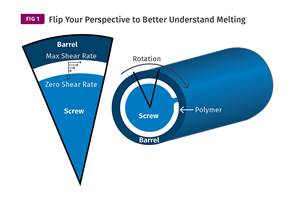EXTRUSION: Understanding The Barrier Gap
All barrier screws are not created equal, and the barrier length and gap can be one of the reasons.
Since barrier screws are being used in so many applications, it’s important to understand all the variables controlling their performance. One of those is the barrier gap. I see all kinds of variations that often do not match the other features of the screw design. I assume many designers have their own calculation to determine the gap, as literature on the subject offers little in the way of guidelines.
Barrier screws are designed to allow melted polymer to move from the solids channel to the melt channel by passing over the undercut barrier. This provides a number of performance advantages that have been described in many articles. But how are the barrier gap, length, and width determined? All three of the dimensions are important.
There are two forces that account for the movement of the polymer across the barrier from the solids channel to the melt channel. First (and usually most important) is drag flow, and second is the pressure difference between the two channels. Since the pressure difference requires very complex computer simulation to approximate its value, most screws will be designed without benefit of that information.
However, not having an estimate of the pressure difference between the channels does not usually lead to a large error except for some very soft polymers. The pressure is typically higher in the solids channel and adds to the drag flow, thereby increasing the flow rate. So drag flow over the barrier can be matched to the calculated drag flow of the screw (QD) for determination of a minimum barrier gap. A simple drag-flow equation for flow between parallel plates (QD=V0 H/2) can be modified to calculate a drag flow (QB) over the screw barrier. This can be rewritten to fit the barrier as:
QB= 1/2(Rev/sec x (Pi)2 x (Screw Dia)2 x gap x helical length)
By inserting a helical length for the barrier and substituting the drag flow of the screw (QD) for (QB), a minimum barrier gap can be determined:
Gap=QD/[1/2( rev/sec x (Pi)2 x (Dia)2 x helical length)]
The width of the barrier flight can negatively impact output, as the wider the flight, the greater pressure drop across the barrier flight. But since most barrier flights are relatively narrow, it seldom has an overriding effect on the design. If necessary, it can also be determined by a modification of the pressure-flow equation, but that requires determination of the viscosity in the gap.
The output of very few smooth-bore single screws exceeds drag flow, so this provides a minimum value for the gap. It is not suitable for grooved-barrel single-screw extruders, where the output typically exceeds drag flow and the pressure flow over the barrier can be significant.
The important thing to note is that this simple calculation can help avoid barrier flights that restrain the output of an otherwise suitable barrier design, and can give some guidance to control excessive gaps. It also shows that the helical length of the barrier is as important as the undercut of the gap.
It would seem that a short barrier length would need a large barrier gap; or conversely, a long barrier length would need a very small barrier gap. Unfortunately QB is not a complete solution because the barrier gap should also approximate the melting rate in the channel or the melt-film thickness. Too large a gap may allow solids to pass over, while too small a gap will restrict them and a melt pool will form in the solids channel, disrupting the melting.
Calculating the melt-film thickness is difficult without a thorough knowledge of the polymer properties and is usually done by computer simulation, although empirical formulas can be used to get very good approximations. Since that information may not be available to some screw designers, the final gap determination is still subject to some adjustment, but QB provides a minimum value.
The solution, then, to a reasonable approximation for the barrier flight has to come from experience and by increasing the gap using some multiple of the calculated gap. Underestimating the gap usually has more severe consequences than overestimating it.
ABOUT THE AUTHOR
Jim Frankland is a mechanical engineer who has been involved in all types of extrusion processing for more than 40 years. He is now president of Frankland Plastics Consulting, LLC. Contact
jim.frankland@comcast.net or (724) 651-9196.
Related Content
Choosing the Right Gearbox and Motor for Your Single-Screw Extruder
Extruder OEMs are typically very good at sizing motors and gear boxes for extrusion applications. But you have the final decision on the acceptance of the design. Here’s what you should consider.
Read MoreHow To Identify Resin Degradation in Single-Screw Extruders
Degradation can occur in many single-screw extrusion operations, and typically occurs due to minor design flaws in the screw. Here is how to track it down.
Read MoreTroubleshooting Flow Surging in Single-Screw Extruders
Surging can cause lower production rates, higher scrap rates, material degradation and higher labor costs. Here is a guide to troubleshooting this problem.
Read MoreUnderstanding Melting in Single-Screw Extruders
You can better visualize the melting process by “flipping” the observation point so the barrel appears to be turning clockwise around a stationary screw.
Read MoreRead Next
Making the Circular Economy a Reality
Driven by brand owner demands and new worldwide legislation, the entire supply chain is working toward the shift to circularity, with some evidence the circular economy has already begun.
Read MoreLead the Conversation, Change the Conversation
Coverage of single-use plastics can be both misleading and demoralizing. Here are 10 tips for changing the perception of the plastics industry at your company and in your community.
Read MoreBeyond Prototypes: 8 Ways the Plastics Industry Is Using 3D Printing
Plastics processors are finding applications for 3D printing around the plant and across the supply chain. Here are 8 examples to look for at NPE2024.
Read More.jpg;width=70;height=70;mode=crop)














